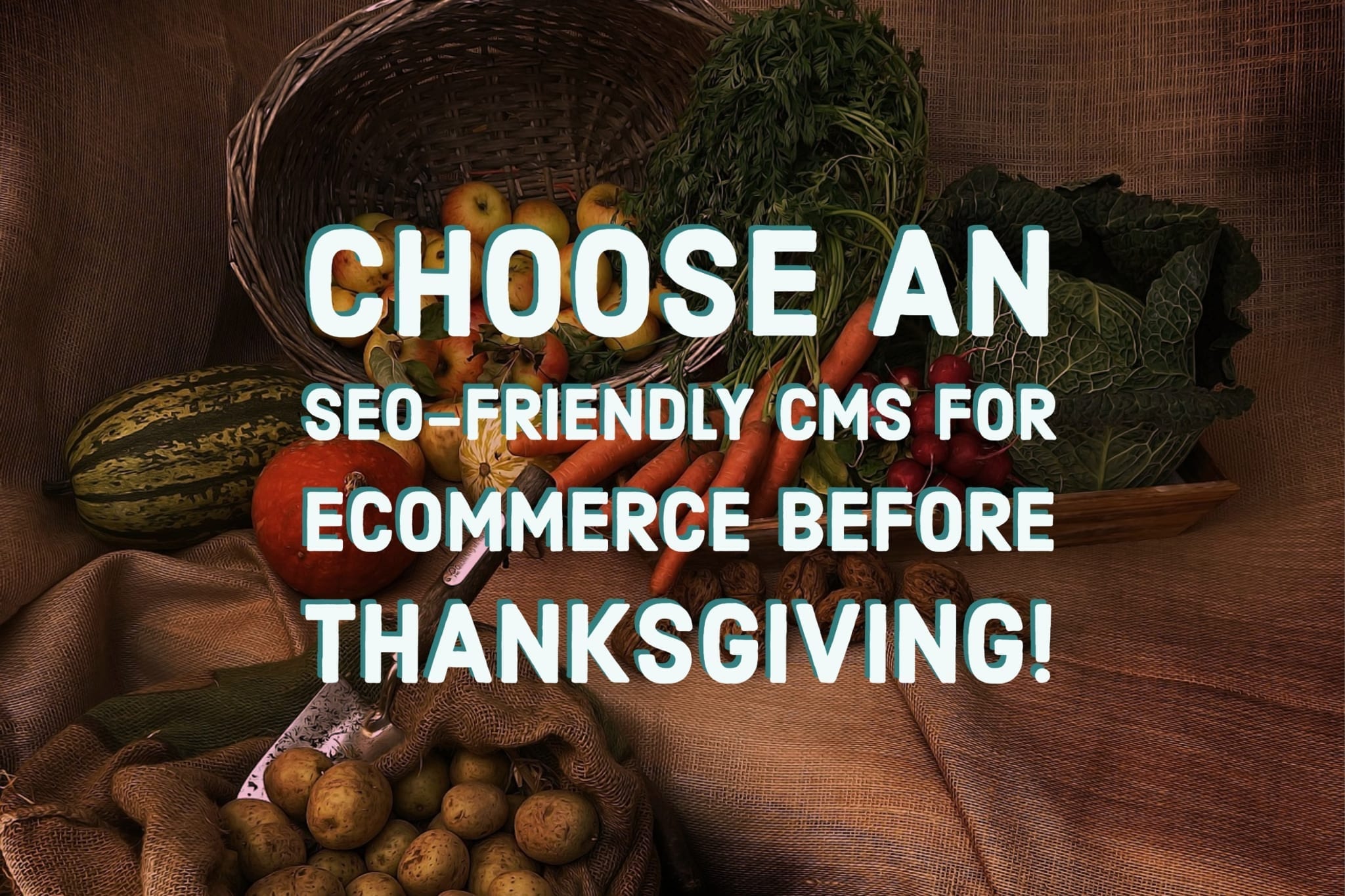As I write today, I’m two days into my second virus of the season. I feel as though this post should come with an errors and omissions disclaimer sort of like the ones you see when posting from a mobile device. In my previous experience trying to write with a headache that flexes like a band around your templates isn’t that fun – but, last week I watched as my associate, Kim Brooks, wrote not one but two articles with the flu so hell, I’m going with it. Mission accepted, Kim.
This week we’ve been talking to our clients a TON about SEO as we start to redesign their websites.
Because an SEO-master is so dependent on their tools, the content management system (CMS) your site is built with, starts to matter when you’re talking to us about “getting your product on page one of Google in 6 months.”
A good CMS should be easy to use, mobile friendly and allow you the flexibility to install tools (plugins, apps, integrations) that will help you sell your products, and critically evaluate your on-page SEO to emulate google rank results.
For eCommerce sites that don’t have $10K/month advertising budgets, SEO is possibly even more important because the market is saturated with options and if your product can’t be found or can easily be “disqualified,” your ROI is toasted. Depending on what type of products you sell, who your audience is and ‘where’ they find out about you is going to greatly affect the type of CMS platform you decide to use.
In this article, I’m going to go full Capterra on you all and break down the best small to mid-size business eCommerce CMS platforms for SEO. Spoiler alert – unsurprisingly, there is really no one-size-fits-all answer here (or is there?) Surprises lurk around every corner…
First, check yourself-
- What product is your product solving?
- What makes you better (what is your unique differentiator)?
- Where is your target market used to buying this product now?
- What channels may be available to you?
- Who is your competition? Who is the market leader?
- What are they doing right?
- What are they doing wrong?
- What makes them interesting?
- How can you ensure/develop/build an experiential e-commerce experience into the customer journey?
- How big are you now and how big do you want or expect to be in the next five years?
Alright, assuming you’ve made some mental notes here that aren’t as wispy as cotton candy – it’s time for the breakdown.
eCommerce SEO
Before we dial into options, it’s probably best to get an understanding of the basic’s – that is, what eCommerce SEO functionalities you’re going to need. If you’re a small to medium-sized shop, you’re probably looking to focus on optimizing your individual product and category pages. To optimize these pages, you need some on-page SEO support which will require your CMS –
- has the ability to create alt tags
- has the ability to optimize your meta-titles, descriptions, and header tags (H1-H6)
- has the ability to optimize URLs and create re=canonical tags
- is mobile friendly
- creates indexable pages
- allows you to edit robots.txt to modify indexability of pages too!
- allows you to create 301 redirects
- has the ability to install/develop an independent blogging platform
- allows you to automatically generate an XML sitemap
- allows you to use your own domain and your own IP address
- has SEO-friendly navigation options
- will allow you to add schema markup to product pages (increasing CTR by + 30%!, no small thing) *Hell, this is even written into the manual!
“Add markup to your product pages so Google can provide detailed product information in rich Search results — including Image Search. Users can see price, availability, and review ratings right on Search results.”
Webmaster Guidelines, Google
While mulling over how to write and optimize product-descriptions is ‘bread and milk’ foundational, it’s a tunnel away from the topic at hand so, in case you were wondering, you can read our awesome article on writing great product descriptions here!
Because we know you don’t have the time to mess around with the wrong eCommerce CMS, let me make good on my promise and break down the store-building CMS options that we have found to be the most suitable for small to medium-sized businesses.
Shopify
We did the research, and while Shopify makes quite the effort to empower their users to implore SEO tactics via their blog and video tutorials, like many ‘rented’ website builders, it fails to give you the whole ‘customization’ package. Renting has its limits and you’re not going to be able to build the advanced SEO ‘extension’ that an ‘owned’ store will allow you to. Let’s face it though when we dial into what Shopify ‘can’t do’ we are talking ‘advanced’ SEO; that means the average SME, this might not be such a deal breaker.
Another reason we love Shopify is that you can build a store quickly and easily – especially using GemPages, this amazing website builder we just found which must cut at least 12 hours off of site-development time. Yes, we are repeating their benefit language precisely but, we swear it’s true, we tested it!
Why it’s great –
- Automatic sitemap generation
- Fast loading / great uptime
- Support features are phenomenal
- Powerful and connected applications
- Easy to use
- Mobile friendly templates and page builder
- Shopify is a growing marketplace with a ton of opportunity to grow and scale your product line
Limitations –
- Limited features for advanced SEO techniques
- You “rent” v. “own” your own store
- Limited ability to modify or customize features in the backend (ex: no subcategories)
- Limited ability to modify/adjust URL structures
- No access to your robots.txt (that is, you can’t easily choose what you’d rather not index) – but, “there’s an app for that” – more here!
- Limited ability to create re=canonical tags (must be custom-coded)
- Structured data must also be custom-coded
WooCommerce
WooCommerce and Shopify are pretty much in a dead heat when it comes to SEO. However, WooCommerce comes with a whole lot more functionality and “ownership” ability than any store-building platform like Shopify, Magento, BigCommerce, etc. will allow. Ownership means you own the website, website content, and images forever. Using a ‘rented’ store-builder can mean that you pay a higher cost overall due to monthly subscription payment costs which in some instances can exceed $3,500/year!
Not for nothing but WooCommerce is one of the biggest and the best “one-size fit’s all solutions” for eCommerce brands large and small and powers over 30% of online stores. That’s a whole lot of Woo compounded by a whole lot of WordPress since Woo and WordPress are forever bound to one another.
With WooCommerce, you can –
- Offer variations on your products, multiple configurations, and instant downloads
- Sell affiliate products
- Customize your website completely using Storefront & other tools
- Customize payment and shipping options
- Scale your store
- Track inventory
- Run detailed reports
- Use integration tools and applications like MyWorks to sync purchases to your bookkeeping software
- Own your website & store completely!
Why it’s great –
- The basic version is free!
- Super straight-forward, no coding required
- You own it. Your data remains yours!
- Cheap and easy to manage, even if you outsource it!
Limitations –
- Bound by WordPress (there could be worse things!)
- Slightly less user-friendly than Shopify (you’re going to have to get use to backend life)
- Functions/features you need for your store may require an upgrade
- Integrations may also tie you into subscription deals which you’ll pay monthly for
Squarespace
While Squarespace may be “easy,” easy doesn’t always mean straightforward when it comes to SEO. Rank Fishken, was recently quoted as tweeting, “I’d avoid them for now if SEO is important to your site’s traffic.” Yikes! Why are we talking about Squarespace then when I promised you an article of “the best” & only the best? Well, it’s complicated but, this is not the end of the story for Squarespace.
With Squarespace, your template’s customization options are going to make the difference between a site you can engineer correctly for SEO and an ‘online brochure.’ Even worse, some Squarespace themes actually force metadata to appear over images. If you don’t want your page description to populate text content automatically (and why would you?), this is a real issue. Especially since forcing data over a hero image isn’t going to help your site rank in search engine results pages (SERPs). Thank god not all themes are created equally when it comes to both metadata & title customization options – some contain tweaks & our friends over at Squarespace have curated a nice little list for you to take care if/when you’re choosing a theme (with SEO in mind, of course).
Additionally, and I know we’ve discussed this before, Squarespace does have customization options many page-builders DO NOT. Such as – customizable URLs, meta titles, alt image text, sitemaps, security certificates, and even 301-redirects (wahoo!). It is also fast-loading, and most templates are extremely mobile-friendly. Since most users are accessing via mobile these days – this matters mucho.
Why it’s great –
- No coding experience required but does allow for custom coding
- Super easy to use right out of the box
- Clean user interface
- Integration options (social, apps, GSC (a.k.a. Google Search Console), etc.)
Limitations –
- Title and meta-description customization options are limited by your template
- Coding & advanced SEO must be used to correctly optimize across your website
- Sincere lack of SEO Plugins to help with tracking
- Structured Data is done automatically unless you want to custom-code your schema from the backend
- Re=canonical tags are non-editable
- Must custom-code pages you do not want Google to index
Create a Website with SEO in Mind!
Whether you are building your eCommerce website for the first time or engaging in a total site redesign, it’s important to build your site with SEO in mind. You need to think about your site’s growth potential. If you plan to expand your product line, your business, or (hello!) be found in the search engines, investing in the right platform that meets your needs is a critical first step. If you still have questions about what platform is right for you or you’d like to talk to us about helping build your digital footprint, give us a holler!
P.S. Bonus Info!
If you’re looking to get started with merchant service’s to tie your store we recommend –
2) Square
3) Payline
4) Paypal Pro
5) Stripe
More to follow!
References-
https://ahrefs.com/blog/ecommerce-seo/
https://ecommerce-platforms.com/compare/best-ecommerce-platform-seo
https://www.webpagefx.com/internet-marketing/is-woocommerce-seo-friendly.html
https://www.linkedin.com/pulse/squarespace-bad-seo-why-your-template-matters-jennifer-villa/
https://www.websitetooltester.com/en/reviews/shopify/pricing/





Hi there, I read your blogs regularly. Your story-telling style is awesome, keep it up! http://detective-zakynthinos.net/
Hi there, I read your blogs regularly. Your story-telling style is awesome, keep it
up!